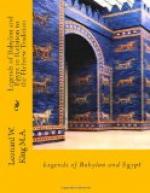(2) The phrase recalls the familiar Egyptian royal designation “son of the Sun,” and it is possible that we may connect with this same idea the Palermo Stele’s inclusion of the mother’s and omission of the father’s name in its record of the early dynastic Pharaohs. This suggestion does not exclude the possibility of the prevalence of matrilineal (and perhaps originally also of matrilocal and matripotestal) conditions among the earliest inhabitants of Egypt. Indeed the early existence of some form of mother- right may have originated, and would certainly have encouraged, the growth of a tradition of solar parentage for the head of the state.
(3) Poebel, Hist. Inscr., p. 124 f.
(4) Tablet I, Col. ii,
l. 1; and cf. Tablet IX, Col. ii. l.
16.
What light then does our new material throw upon traditional origins of civilization? We have seen that in Egypt a new fragment of the Palermo Stele has confirmed in a remarkable way the tradition of the predynastic period which was incorporated in his history by Manetho. It has long been recognized that in Babylonia the sources of Berossus must have been refracted by the political atmosphere of that country during the preceding nineteen hundred years. This inference our new material supports; but when due allowance has been made for a resulting disturbance of vision, the Sumerian origin of the remainder of his evidence is notably confirmed. Two of his ten Antediluvian kings rejoin their Sumerian prototypes, and we shall see that two of his three Antediluvian cities find their place among the five of primitive Sumerian belief. It is clear that in Babylonia, as in Egypt, the local traditions of the dawn of history, current in the Hellenistic period, were modelled on very early lines. Both countries were the seats of ancient civilizations, and it is natural that each should stage its picture of beginnings upon its own soil and embellish it with local colouring.
It is a tribute to the historical accuracy of Hebrew tradition to recognize that it never represented Palestine as the cradle of the human race. It looked to the East rather than to the South for evidence of man’s earliest history and first progress in the arts of life. And it is in the East, in the soil of Babylonia, that we may legitimately seek material in which to verify the sources of that traditional belief.
The new parallels I have to-day attempted to trace between some of the Hebrew traditions, preserved in Gen. iv-vi, and those of the early Sumerians, as presented by their great Dynastic List, are essentially general in character and do not apply to details of narrative or to proper names. If they stood alone, we should still have to consider whether they are such as to suggest cultural influence or independent origin. But fortunately they do not exhaust the evidence we have lately recovered from the site of Nippur, and we will postpone formulating our conclusions with




